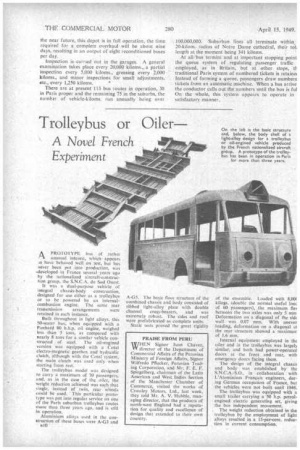Trolleybus or Oiler— A Novel French
Page 18

If you've noticed an error in this article please click here to report it so we can fix it.
Experiment
APROTOTYPE bus of .rather unusual interest, which • appears Lo have behaved well on test, but has never been put into production, was ',developed in France several years ago by the nationalized aircraft-construction group, the S.N.C.A. du Sud Quest.
It was a dual-purpose vehicle of integral chassis-body construction, designed for use either as a trolleybus or to be powered by an internalcombustion engine. The same rear
transmission arrangements were retained in each instance.
Built throughout in light alloys, this 50-seater bus, when equipped with a Panhard 80 b.h.p. oil engine, weighed less than 5 tons, as 'compared with nearly 8 tons for a similar vehicle constructed of steel. The oil-engined version was equipped with a Cotal electro-magnetic gearbox and hydraulic clutch, although with the Cotal system, the main clutch was used only when starting from rest.
The trolleybus model was designed to carry a maximum of 70 passengers, and, as in the case of the oiler, the weight reduction achieved was such that single, instead of twin, rear wheels could be used. This particular prototype was put into regular service on one of the Paris suburban trolleybus routes more than three years ago, and is still in operation.
Aluminium alloys used in the coostruction of these buses were A-G3 and A-G5. The basic floor structure of the combined chassis and body consisted of ribbed light-alloy plate with double channel cross-bearers, and was extremely robust. The sides and roof were prefabricated as complete units.
Static tests proved the great rigidity
of the ensemble. Loaded with 8,00( kllogs. irdouble the normal useful boat of 60 passengers), the maximum flo between the two axles was only 5 mm Deformation on a diagonal of the sick wall was 0.07 mm. With uneven loading, deformation on a diagonal ot the rear structure showed a maximurr of 1.6 mm.
Internal equipment employed in the oiler and in the trolleybus was largely similar, and both had power-operated doors at the front and rear, with emergency doors facing them.
The design of the integral chassis and body was established by the S.N.C.A.-S.O., in collaboration with L'Aluminium Francais engineers, during German occupation of France, but the vehicles were not built until 1946.
The trolleybus was equipped with a small trailer carrying a 50 h.p. petrolengined electric generating set, giving the bus independent movement.
The weight reduction obtained in the trolleybus by the employment of light alloys resulted in a 15-per-cent. reduction in current consumption.


























